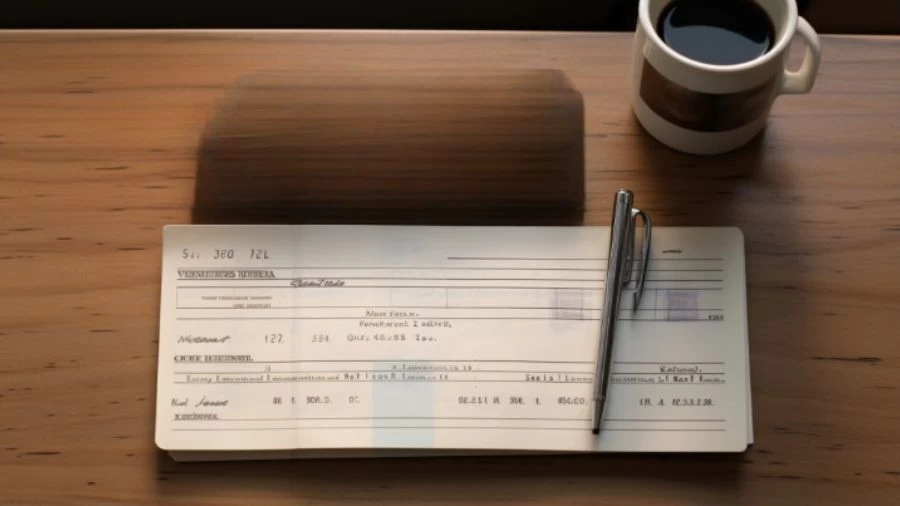
Deposit Slip And How to Fill Out a Deposit Slip?
A deposit slip is a vital document for precise fund deposits, including personal info, date, signature, cash and check details, and a subtotal calculation.
by Sai V
Published Sep 06, 2023 | Updated Sep 06, 2023 | 📖 8 min read
On This Page
- Deposit Slip
- How to Fill Out a Deposit Slip?
- How to Get a Deposit Slip?
- How Do Deposit Slips Work?
- Benefits of Deposit Slips
- Can I Deposit Money Without Using a Deposit Slip?
- Are Banks Required to Maintain Records of Deposit Slips?
- Is a Deposit Slip Always Required?
- When Do You Need to Use a Deposit Slip?
- Where Can You Find the Routing Number on a Deposit Slip?
Deposit Slip
A deposit slip is a crucial document used by bank customers when depositing funds into their accounts. It includes essential information like the deposit date, the depositor's name, account number, and the breakdown of deposited amounts, whether it's checks or cash. Moreover, it serves as proof that the bank has acknowledged the funds' receipt, ensuring accuracy and transparency in the deposit process.
This compact form simplifies deposit transactions, aiding customers and banks in efficient record-keeping. Customers are encouraged to retain deposit slip copies for their records, making it a valuable tool for personal financial management and reconciling bank statements. In essence, the deposit slip streamlines deposits, benefiting both customers and banks by facilitating smooth transactions and maintaining clear financial records.
How to Fill Out a Deposit Slip?
Filling out a deposit slip involves providing personal information, dating and signing it, listing cash and checks separately, and calculating a subtotal for accurate crediting of funds to your account.
Personal Information: Begin by providing your personal information at the top of the deposit slip. Write your full name and your account number clearly. Accuracy is crucial to ensure your deposit goes to the correct account.
Date: Next, indicate the current date on the deposit slip. Make sure the date is accurate as it reflects when the deposit is being made.
Signature: If you're depositing cash or any part of a check, your signature is required on the designated line. This signature serves as your authorization for the deposit.
Cash Deposit: If you have cash to deposit, use the sections provided for currency (bills and coins). Typically, there are separate boxes for the full dollar amount and the cents portion (decimal). Enter the amount of cash you're depositing in these sections. If you have no cash, leave this section blank.
Check Deposit: For each check you're depositing, list them individually on the deposit slip. Include the check number and the amount for each check. Each check gets its own line. If you have more checks than space allows on the front of the slip, you can use the back of the slip for additional entries. This helps both you and the bank keep track of each check being deposited. If you have no checks, leave this section blank.
Cashback (Optional): If you're depositing money but also want to receive some cashback, indicate the desired amount in the "Less Cash Received" section. This section is usually located at the bottom of the deposit slip.
Calculate Subtotal: Add up the total amount of cash and checks you're depositing. This subtotal represents the overall deposit into your account. Ensure that your calculations are accurate.
How to Get a Deposit Slip?
To obtain a deposit slip, you have a few straightforward options. First, check the back of your checkbook, where deposit slips are often included as part of the booklet. If you don't have a checkbook or can't find one there, your local bank branch is another reliable source.
At the counter of your bank branch, you'll usually find deposit slips readily available for customers. In case neither of these options is viable, simply approach the teller window at your bank and request a deposit slip. Bank staff are typically happy to assist you by providing one, ensuring a smooth and convenient deposit process.
How Do Deposit Slips Work?
Deposit slips are essential forms used by bank customers when depositing money into their accounts. These slips include crucial details like the deposit date, depositor's name, account number, and the amounts being deposited, whether in the form of cash or checks. Customers can find these slips at bank branches and are required to fill them out before approaching the teller. Deposit slips ensure accuracy in crediting funds to the correct account and serve as proof of the transaction.
After verification, the bank processes the deposit and provides a receipt, confirming the successful transaction.Additionally, some checkbooks come with pre-printed deposit slips, simplifying the process by including account and routing numbers. Deposit slips are indispensable tools for maintaining transparency and precision in bank transactions, enabling customers to communicate their deposit intentions clearly and maintain accurate financial records.
Benefits of Deposit Slips
Deposit slips offer essential benefits to both banks and customers. They serve as a crucial tool for accountability by helping banks maintain a written ledger of deposits throughout the day, ensuring that no funds go unaccounted for. For customers, deposit slips function as a de facto receipt, providing proof that the bank correctly acknowledged and deposited the specified amount into the designated account.
This documentation becomes especially valuable when discrepancies arise in reported deposit amounts, offering a safeguard against potential errors or misunderstandings. Furthermore, deposit slips contribute to transaction history, enabling customers to reconcile account statements and aiding in legal matters when disputes or investigations arise. Overall, deposit slips play a vital role in maintaining transparency, accuracy, and trust in banking transactions for both parties involved.
Can I Deposit Money Without Using a Deposit Slip?
Yes, you can deposit money without using a deposit slip, especially if you're dealing with check deposits. Many major banks offer a convenient solution through their mobile banking apps. After enrolling in your bank's mobile app, you can simply use your smartphone's camera to capture clear images of the front and back of the check. Then, submit these images through the app as a deposit. This method eliminates the need for a physical deposit slip and allows you to deposit checks quickly and securely.
It's worth noting that there may be limits on the amount you can deposit using this method, as well as restrictions on cash deposits, which usually require a visit to a bank branch or ATM.However, for cash deposits or other forms of deposits, you may still need to use a deposit slip. When depositing cash, you typically need to provide a deposit slip with details such as your account number and the amount of cash being deposited. In such cases, it's advisable to visit your bank's physical branch or ATM for the transaction.
Are Banks Required to Maintain Records of Deposit Slips?
Yes, banks are indeed required by federal law to maintain records of deposits that exceed $100 for a minimum of five years. This regulatory mandate is in place to ensure transparency, accountability, and compliance with financial regulations. While banks do have the option to retain these records for a more extended period, the standard practice in the modern banking industry is to maintain these records in digital formats rather than traditional paper copies.
Digital storage not only allows for easier retrieval and management of the information but also aligns with the industry's move towards greater efficiency and sustainability in record-keeping practices. It's essential for banks to adhere to these regulations to safeguard financial data and assist in potential audits or investigations while also streamlining their operations in an increasingly digitized world.
Is a Deposit Slip Always Required?
No, a deposit slip is not always required when making a deposit at a bank or credit union. In certain situations, such as ATM deposits at your bank's location, you can simply follow on-screen instructions to indicate your account and insert your checks without the need for a deposit slip. Some banks also offer teller-assisted deposits where you can hand over the money to a teller without filling out a slip. Additionally, mobile deposit services via banking apps allow you to skip deposit slips entirely by capturing check images for electronic processing. The need for a deposit slip depends on the specific deposit method and the policies of your financial institution.
When Do You Need to Use a Deposit Slip?
A deposit slip is required when you intend to receive cash back from your deposit at a bank. If your purpose is solely to deposit funds into your account without any immediate cash withdrawal, you typically do not need to sign a deposit slip.
The process of using a deposit slip involves filling out essential information such as your account number, the amount being deposited (both in cash and checks), and any relevant endorsements. It serves as a record of the transaction, helping the bank ensure accuracy and traceability in case of any discrepancies. However, it's worth noting that if you choose to deposit funds through an ATM, you may not need a physical deposit slip, as the machine can often read and process the information electronically.
Where Can You Find the Routing Number on a Deposit Slip?
The routing number on a deposit slip can be easily located at the bottom of the slip. Typically, this nine-digit number is printed near the left-hand corner, either at the bottom or slightly above the magnetic ink character recognition (MICR) line. Alongside the routing number, if you're using a pre-printed deposit slip, your account number will also be displayed, making it convenient for both depositing money and ensuring accurate crediting to your account.
However, it's essential to remember that the routing number found on your deposit slip might not always be the same as the one required for specific banking transactions such as setting up direct deposits or wire transfers. To prevent any errors in your financial transactions, it's advisable to double-check and confirm the correct routing number with your bank, especially when dealing with electronic fund transfers.
Deposit Slip - FAQs
1. What is the purpose of a deposit slip?
A deposit slip is used to deposit funds into a bank account and provides a record of the transaction.
2. How do I obtain a deposit slip?
You can get a deposit slip from your checkbook, your bank branch, or by requesting one from a teller.
3. Is a deposit slip always required when depositing money?
No, it's not always required; some deposit methods, like mobile banking apps, may not necessitate a physical deposit slip.
4. Do I need to keep a copy of my deposit slip?
Yes, it's a good practice to retain a copy for your records, especially for reconciling bank statements and proof of deposit.
5. What information is essential on a deposit slip?
A deposit slip should include your name, account number, the deposit date, details of cash and checks being deposited, and your signature for authorization.




